| Space Launch Report: Antares (Taurus II) | |||||||||||||||||||||||||||||||||||||||||||||||||||||||||||||||||||||||||||||||||||||||||||||||||||||||||||||||||||||||||||||||||||||||||||||||||||||||||||||||||||||||||||||||||||||||||||||||||||||||
| Home On the Pad Space Logs Library Links | |||||||||||||||||||||||||||||||||||||||||||||||||||||||||||||||||||||||||||||||||||||||||||||||||||||||||||||||||||||||||||||||||||||||||||||||||||||||||||||||||||||||||||||||||||||||||||||||||||||||
First Antares Flight Vehicle is Loaded onto its Transporter/Erector in Wallops Island Horizontal Integration Facility on April 4, 2013 Orbital (OSC) began in-house design of a new medium-class launch vehicle, originally named "Taurus II" but now known as "Antares", in 2007. In early December 2007, Orbital provided an initial glimpse of its plans. The company said that Taurus II would, carry Delta II-class payloads by combining elements of Orbital's existing Pegasus, Taurus, and Minotaur launchers with "hardware from one of the world’s leading launch vehicle integrators". In its October 18, 2007 report of third quarter earnings, the company disclosed that such a development, tenatively named "Taurus II" (or "Taurus 2"), could cost $40-45 million in 2008, but could also increase corporate revenue by as much as $25 million. On February 19, 2008, NASA awarded a Commercial Orbital Transportation Services (COTS) Demonstration Mission to Orbital. The $170 million project award, recompeted after NASA cancelled RocketPlane Kistler's original COTS award, was expected to be combined with $150 million of Orbital's own money to develop Taurus II and a new "maneuvering spacecraft" named "Cygnus". Taurus II and Cygnus would be developed to perform a
demonstration of commercial cargo delivery to the International Space Station (ISS).
Cygnus would carry up to 2.3 tonnes of pressurized and unpressurized cargo on
speciallized interchangeable modules. A reentry version would be able to return as
much as 1.2 tonnes of cargo from ISS to Earth.
Orbital’s COTS demonstration mission was initially planned to occur before the end of 2010, but subsequently slipped into 2011. The company planned to develop a system capable of conducting as many as eight ISS cargo flights per year by 2012-13. Cygnus, based on Orbital's satellite design skills, would be developed and assembled in Dulles, Virginia and Greenbelt, Maryland. Taurus II would be assembled and tested in Ukraine, in Dulles, and in Chandler, Arizona. Taurus II, initially slated to fly from rebuilt Launch Area 0-A at Wallops Island, Virginia, would be able to lift 3.7 to 5.4 tonnes to low earth orbit, depending on launch site, orbit altitude, and orbit inclination. On December 23, 2008, NASA awarded a $1.9 billion Commercial Resupply Services (CRS) contract to Orbital, purchasing eight ISS resupply missions to be launched by Taurus II/Cygnus from Wallops Island. The first mission was slated for October 2011. The contract extended through the end of 2016. Orbital planned for Taurus II to be profitable at
relatively low flight rates. The company expected to perform no more than five or
six Taurus II flights per year by 2015. Antares is a Ukrainian/Russian/American Rocket - Perhaps the World's Most International Launch Vehicle. It will Orbit an Italian/American Spacecraft to an International Space Station.. Yuzhnoe/Yuzhmash of Ukraine will develop and build Taurus II's 3.9 meter diameter first stage. The stage will use kerosene and liquid oxygen tanks with the same diameter as Zenit 2/3, which is also made by Yuzhnoe/Yuzhmash. Twin Kuznetsov NK33 engines, modified by Aerojet and cataloged as "AJ26-62" engines, will power the Taurus II first stage. During the 1990s, Aerojet acquired rights to import about 46 of the engines from ND Kuznetsov Joint Stock Company Scientific-Technical Complex of Samara Russia. The engines were originally developed for the Soviet Union's N1 launch vehicle. More than 50 more NK33s are reported to remain in storage in Samara. Aerojet negotiated a license to produce new copies in the U.S., but such production would require several years to initiate. In 2008, Orbital reported that it had rights to 36 NK33 engines and that it planned to purchase 30 more, providing a total of 33 flight sets. Each staged combustion cycle kerosene/liquid oxygen NK33 develops nearly 153 tonnes of sea level thrust and 167 tonnes in vacuum at 100% throttle, but the engines will be throttled up to 108% for Taurus 2. The engines are highly efficient, with specific impulse ratings of 297 seconds at sea level and 331 seconds in vacuum. The first stage will carry 240 tonnes or more of
propellant, weigh 18.75 tonnes empty, and stand roughly 28 meters tall. The high
thrust provided by two NK33 engines means that Taurus II will not need strap-on boosters
to match Delta II performance, but such boosters could presumably be added to increase
performance in the future.
Taurus II will use a new "Castor 30" solid fuel second stage motor produced by ATK. Castor 30, a derivative of the longer Castor 120 motor, will weigh about 14 tonnes loaded, will burn for 155 seconds, and will produce about 26.4 tonnes of average thrust. Orbital will add a cold-gas three-axis attitude control system to the Castor 30 to create a stage that can coast and maneuver. Guidance and control of the stage and vehicle will be provided by an Avionics Module mounted atop the stage. Orbital's Taurus II fact sheet was updated in May 2009 to show a follow-on "enhanced" second stage option. The stage would be powered by a new Pratt & Whitney Rocketdyne PWR35M engine that would burn LOX and Methane to produce 35,000 lb (15.88 tonne) class thrust. With this stage, Taurus II could move beyond Delta II payload capability, hauling up to 7.6 tonnes to low earth orbit or 1.8 tonnes to Earth escape velocity when topped with a Star 48 third stage. In early 2010, the "enhanced" stage design shifted toward kerosene/LOX, potentially to be powered by the Russian RD-0120 staged combustion engine used by Soyuz 2.1b. In January 2009, Applied Aerospace Structures Corporation of Stockton, California announced that it would build composite structures for Taurus II, including the payload fairing, fairing adapter, interstage, Stage 2 motor adapter, payload fairing adapter, and avionics cylinder. Deliveries were expected to begin in late 2009. A maneuvering bipropellant hypergolic third stage could eventually see use with Taurus II, though it would not be used for COTS demo missions. The stage, equipped with a bipropellant hypergolic pressure-fed propulsion system similar to equipment used by Orbital's Star2bus satellites, has been called an Orbit Raising Kit (ORK). The ORK could provide orbit raising maneuvers for higher-altitude missions. For higher energy missions, Taurus II could use a Star 48V solid propellant kick motor. A Star 48V on top of a Taurus II would be able to boost more than 1.1 tonnes to Earth escape velocity. Orbital has examined Taurus II designs before. A Taurus II design studied during the early 1990s used two Castor 120 motors stacked in series topped by a new bi-propellant liquid stage. As many as eight Castor IVA strap-on boosters augmented the core stage. The most powerful variant would have matched Delta II capability. Taurus II will stand roughly 40.5 meters tall, assuming
a 9-10 meter long payload fairing. The 2.34 meter diameter Castor 30 second stage
would fit within a 3.9 meter diameter, 4-5 meter tall "interstage" section.
NK-33 Testing in Samara During 2009, construction of Taurus II facilities began at Wallops Island. The old Conestoga service tower at Pad 0-A was demolished to make way for a brand new Taurus II pad. Construction of a Horizontal Integration Facility also began. Taurus II will be horizontally integrated with a mated payload in the HIF. A wheeled transporter/erector will roll out and erect the rocket on its launch pad about 24 hours prior to launch. In December 2009, ATK tested its Castor 30 motor in a high altitude chamber at the Arnold Engineering Test Center in Tennessee. The stage performed a 150 second burn, producing a peak 32.66 tonnes of thrust. Russia's SNTK initiated extended-duration
"margin" testing of an NK-33 engine at the Vintay test range in Russia's Samara
region beginning in the Fall of 2009. A successful 220 second test on October 1 was
followed by an aborted test five days later. The abort, which created a fire on the
stand, occurred 160 seconds into the test when pulsations began in a test stand oxidizer
feed line. Testing resumed in early 2010. In early March, an NK-33
performed three test runs for a cumulative 600 seconds, including runs twice as long as
the planned 235 second Taurus II burn.
A pathfinder AJ26-62 engine was shipped to NASA's Stennis Space Center Test Stand E-1 on February 23, 2010 for configuration verification testing, to verify changes made by Aerojet to the original NK-33 engine and to measure engine performance in its flight set-up. The engine performed an initial 10 second "readiness firing" on November 11, 2010. A second, 55-second hot-fire acceptance test took place on December 16, 2010. A third hot-fire test for engine control valve tuning was subsequently canceled after crews determined it was not needed. The "E1" engine was removed from the Stennis E-1 stand in January 2011. Engine "E2" immediately took its place. E2 completed a 54 second acceptance firing on February 7, 2011. Afterward, the engine was shipped to Wallops Island for integration with the first Taurus 2 first stage. Meanwhile, construction was underway at Wallops Island Pad 0A, where an entirely new elevated pad structure was being erected to replace the old Conestoga pad. A new Horizontal Integration Facility was also rising on the island. In Ukraine, Yuzhnoe/Yuzhmash completed the pathfinder Taurus 2 first stage on October 8, 2010. The stage underwent acceptance testing in Ukraine prior to being shipped to Wallops Flight Facility, where it arrived in December, 2010. The stage was said to weigh 13.154 tonnes dry (probably without engines installed), extend 27.44 meters in length, and have a 3.9 meter diameter. The next first stage was delivered to Wallops during April 2011. "Vehicle No. 1" was to be used for static testing on the launch pad while "Vehicle No. 2" was to perform the first Risk Reduction Flight. After its static testing, "Vehicle No. 1" was to be refurbished for use on a later mission. On March 22, 2011, the Horizontal Integration Facility at Wallops was dedicated. Pad 0A was nearing completion by that date. In early April, 2011, NASA announced that it would fund
a Taurus 2 Risk Reduction Flight. The test flight, to be performed without a live
Cygnus spacecraft payload, would occur no earlier than October 2011. Prior to the
launch, Orbital would use the pathfinder stage to test launch site equipment in an effort
culminating in a static test firing on the new pad. On April 25, 2011, Orbital announced that it had directed ATK to develop a more powerful upper stage named "Castor 30XL". The $57 million effort would lengthen the "Castor 30A" stage, used for the first two Taurus 2 flights, by about 40% and likely increase propellant loading by nearly 80%. An upgraded "Castor 30B", equipped with an extended nozzle, would power Flights Two and Three before Castor 30XL would enter service on Flight Five, creating a new "Taurus IIe" model. It was not immediately clear if the decision halted, or merely shelved, plans for the previously discussed "enhanced" liquid upper stage. Taurus IIe would, according to the annoucement, be able to lift 6 tonnes to LEO from Wallops, bettering Delta II performance and nearly matching Delta II Heavy results. It would boost 4.2 tonnes to a 600 km polar orbit if launched from Vandenberg AFB or from Kodiak in Alaska. Taurus IIe would fly beginning in 2013. Adding a Star 48BV third stage, also made by ATK, atop a
Castor 30XL would create a "Taurus IIh". This three-stage rocket would be
able to boost 1.1 tonnes to Earth escape velocity from Wallops. Taurus IIh would be
available in 2014.
Castor 30XL was successfully test fired for the first time on March 28, 2013 at the U.S. Air Force's Arnold Engineering Development Complex (AEDC) in Tennessee. Orbital planned to establish a new Taurus II west coast launch site that would be ready in 2014. Vandenberg and Kodiak were both under consideration.
After successfully testing the first
three AJ-26 engines, the program suffered a setback when a fourth engine suffered a
failure during a June 9, 2011 static test at Stennis Space Center's E-1 test stand.
The engine caught fire during the aborted test because of a kerosene fuel leak from an
engine manifold. The root cause was subsequently determined to be stress corrosion
cracking of the 40-year old metal. The fire damaged the engine to such an extent
that it had to be replaced with another engine in the delivery plan, although the engine
was deemed repairable if ultimately necessary. The replacement engine was
successfully hot-fire tested on September 28, 2011 after improved inspection protocols had
been implemented. Another engine was tested in mid-November, 2011.
In mid-November, the first complete AJ-26 propulsion system was mated to Vehicle No. 1 at the Wallops Island HIF. By that time, both a live Castor 30 second stage motor and a Cygnus payload simulator had been delivered to the facility. Antares On December 12, 2011, Orbital Sciences Corporation announced that Taurus II would be renamed "Antares". The name was announced prior to the beginning of what the company called the "operational phase" of the program, with three launches then planned to occur in 2012. Orbital stuck with its tradition of using "Greek-derived celestial names" for its rockets. Antares, among of the brightest stars in the sky, is in the constellation Scorpius. At the time of the name change, Antares had a 10 launch
backlog, including an initial test launch in 2012 followed by a demonstration mission
later in the year. Both flights were to be performed under the Commercial Orbital
Transportation Services (COTS) agreement with NASA - a program intended to develop a cargo
transportation system for the International Space Station (ISS). Antares would also
be used for eight subsequent contracted Commercial Resupply Services (CRS) missions.
The latter missions were part of a $1.9 billion agreement to deliver cargo to the
ISS from 2012 through 2015.
First Antares Vehicle Stage, Used for February 2013 Hot Fire Test at Wallops Launch site delays pushed the schedule back. An Antares first stage, serving as a pathfinder, was rolled out to the pad during April 2012, but only for mechanical fit checks. The stage was returned to the pad in October, 2012 for cold flow testing. Those tests, involving propellant loading, were not completed until January 2013, a process that was delayed by the passage of Hurricane Sandy. On February 22, 2013, Orbital Sciences successfully
performed a hot fire test of the pathfinder Antares first stage at Wallops Island.
The test, performed at launch Pad 0A, began at 23:00 UTC and lasted for 23 seconds, during
which time the AJ26 engine pair generated about 308 tonnes of thrust. It was the
first time that an integrated test of two AJ26 engines and the first stage had been
performed. Second Antares First Stage Rolled Out with First "A-ONE" Flight Vehicle on April 6, 2013. The first Antares flight vehicle, consisting of the second first stage to be delivered and the first Castor 30 stage, rolled out to Wallops Island Pad 0A on April 6, 2013. The vehicle included a dummy Cygnus spacecraft. The A-ONE test flight was planned to take place in mid-April 2013 as a ten minute test flight slated to boost the second stage and payload simulator into a 250 x 300 km x 51.6 deg orbit.
After nearly two years delay from original plans, Orbital Science's Antares launch vehicle succeeded on its first, "COTS Risk Reduction" flight. Antares A-ONE boosted its 3.8 tonne simulated Cygnus payload to orbit from Wallops Island, Virginia on April 21, 2013. At about 277.45 tonnes gross liftoff weight, it was the largest rocket ever to fly from Wallops. The Ukrainian/Russian/American built rocket rose from
Pad 0A at 21:00 UTC on 332.94 tonnes of thrust produced by its two Aerojet AJ-26 (rebuilt
Russian NK-33 engines dating from the 1970s) LOX/RP1 engines. The engines burned for
230 seconds before shutting down. Separation of the Ukrainian built first stage
occurred five seconds later.
The ATK Castor 30A powered second stage coasted for about 93 seconds before igniting. During the coast, the payload fairing separated at 320 seconds, followed within ten seconds by separation of the 3.9 meter diameter interstage. Second stage ignition occurred at T+328 seconds, beginning a 155 second burn that boosted the vehicle to a 241 x 260 km x 51.6 deg orbit. Castor 30A averaged 29.83 tonnes of thrust during its burn. Payload separation occurred about 10 minutes after engine start. A set of microsatellites subsequently deployed. All of the satellites and the upper stage were expected to reenter within a few weeks.
Although the payload was injected into a slightly lower orbit than originally announced, Orbital officials said that the rocket had functioned as planned. It was the first of ten Antares flights planned to occur
during the next three years to haul cargo to the International Space Station. The
next flight will orbit the first live Cygnus cargo hauler on a test flight to ISS.
The remainder of the flights will be operational Cygnus missions, with most using a more
powerful Castor 30XL second stage. First Flight Cygnus was Mated to Antares in early September, 2013 The second flight Antares was assigned to the ORB-D1 mission, planned to be the first flight test of a Cygnus cargo hauling spacecraft. The goal of the mission was to test Cygnus in orbit, to test rendezvous and, if all goes well, berthing with ISS, and to haul a small amount of cargo to the station. Cygnus was mated to Antares in the HIF during early September, 2013. The payload
fairing encapsulation occured on September 9, 2013. On September 13, 2013, Antares and Cygnus rolled out to Pad 0A at Wallops Island. At the time of the rollout, launch was planned to occur four days later. On September 18, 2013, the second Antares 110 successfully orbited the first Cygnus spacecraft after an 14:58 UTC launch from Wallops Island, Virginia. The ORB-D1 mission was lofted into low earth orbit en route to a cargo delivery demonstration mission to the International Space Station. The Antares/Cygnus launch took place from Pad 0A at Wallops Island. Cygnus consisted of an Orbital Sciences-built propulsion module and a cylindrical cargo module built by Thales Alenia Space in Italy. Antare's Ukrainian-built, Russian-powered first stage performed a 3 minute 53 second burn. The upper stage stack separated and coasted for 1 minute 36 seconds to an altitude of 189 km before the second stage ignited for its 155 second burn. Cygnus separated about 10 minutes after liftoff into a 255 x 288 km x 51.64 deg orbit. For this "ORB-D1" mission, Cygnus weighed about 4,100 kg. Its pressurized cargo module had about 18 cubic meters of internal volume, which was partially filled with 700 kg of cargo for the Expedition 37 crew. The spacecraft used a Japanese-built IHI BT-4 main thruster that produced 45.4 kgf thrust, 32 Aerojet Rocketdyne control thrusters that each produced 2.7 kgf thrust, and twin solar panels built by EADS Astrium Dutch Space. Cygnus will perform a four day check out mission before being allowed to approach ISS for capture and berthing by the station's robot arm.
It was the second and final launch of an Antares 110
variant, which uses an ATK Castor 30A solid fueled second stage motor. The next two
Antares/Cygnus launches will use Antares 120 rockets with higher performing Castor 30B
motors. Subsequent launches will use Antares 130 rockets with substantially more powerful
Castor 30XL motors.
Orbital Sciences launched its third Antares rocket from
Wallops Island, Virgina on Janaury 9, 2014 with the company's first operational Cygnus
cargo mission to the International Space Station. The Orb-1 Commercial Resupply Services
mission, the first of eight currently planned for NASA, began from Launch Complex 0A -
part of the Mid-Atlantic Regional Spaceport - with an 18:07 UTC liftoff. AJ-26 Static Test Failure On May 22, 2014, another AJ26-62 engine suffered an "anomaly" during a static test at NASA's Stennis Space Center Test Stand E-1. The engine, reportedly heavily damaged in the incident that occurred approximately 30 seconds into a planned 54 second test, was being tested for a 2015 launch assignment. It was the second known AJ26 failure at Stennis. The first occurred during 2011. The impact of the failure on a planned June launch of the fourth Antares with Cygnus on the Orb-2 ISS resupply mission was to be determined.
Orbital Sciences' Antares boosted a Cygnus spacecraft
into orbit from Wallops Island, Virginia on July 13, 2014 to begin NASA's Orb-2
International Space Station resupply mission. Cygnus Orb-2, named "Janice Voss"
in honor of the late former Orbital employee and NASA astronaut, carried 1,493.8 kg of
crew supplies, vehicle hardware, science equipment, and other equipment inside its
cylindrical pressure hull. Including cargo, Cygnus weighed about 4.923 tonnes at
liftoff. It was the fourth Antares launch, the third Cygnus
spacecraft flight, and the second contracted ISS cargo supply mission for Cygnus.
"Antares 120", a variant with a Castor 30B second stage, flew for the second and
final time during the mission. "Antares 130" with a longer, more powerful Castor
30XL motor will perform subsequent ISS cargo missions beginning later in 2014. Cygnus "Janice Voss" reached ISS on July 16, 2014.
The fifth Orbital Sciences Antares rocket suffered a fiery failure moments after
liftoff with the Orbital CRS-3 (Orb-3) Cygnus ISS resupply mission from Wallops Island,
Virginia on October 28, 2014. Flying for the first time as an Antares 130 variant with a
lengthened Castor 30XL second stage, the rocket lifted off from Pad 0A at 22:22 UTC. The big rocket momentarily hung in midair before beginning to fall, engine section
first, trailing a stream of fire. At about T+24 seconds, the nearly fully fueled Antares
rocket impacted between the beach and the pad itself, creating a huge fireball that flung
debris in all directions. An intense post-impact fire that appeared to involve pieces of
the second stage solid propellant burned for many minutes.
Orbital CRS-3 included a Cygnus spacecraft loaded with 2.215 tonnes of cargo for the
International Space Station, heaviest-ever for Cygnus which weighed about 5.644 tonnes
including cargo. The cargo included crew provisions, research hardware, emergency
equipment, spacewalk supplies and packing materials. It was slated to stay at ISS for
about one month until returning to a destructive reentry with about 1.36 tonnes of trash.
Although the cause of the failure was not known immediately after launch, attention was expected to focus on the AJ-26 main engines, which are decades-old NK-33 Russian rocket engines that have been refurbished by U.S. Aerojet-Rocketdyne. On May 22, 2014, an AJ-26 being test fired at Stennis Space Center suffered a catastrophic failure 30 seconds into a planned 54 second burn. The failure destroyed the engine and triggered an investigation. Orbital did not reveal the cause of the failure and damage to the test stand had
prevented renewed testing by the time of the Orb-3 liftoff. The Orb-2 and Orb-3 Antares
engines, which had previously been tested at Stennis before the May failure, were cleared
for flight following borescope inspections and a review of their own test firing data.
Date Vehicle No. Payload Mass Site Orbit ----------------------------------------------------------------- 04/21/13 Antares 110 A1 Cygnus Mass Sim. 3.8 WI 0A LEO 09/18/13 Antares 110 A2 Cygnus ORB-D1 4.13 WI 0A LEO/ISS 01/09/14 Antares 120 A3 Cygnus/Orb 1 4.69 WI 0A LEO/ISS 07/13/14 Antares 120 A4 Cygnus/Orb-2 4.923 WI 0A LEO/ISS 10/28/14 Antares 130 A5 Cygnus/Orb-3 5.644 WI 0A [FTO][1] ----------------------------------------------------------------- [1] Failed at T+14 sec. Fell back near launch pad. ----------------------------------------------------------------- References Taurus II Users Guide at http://www.orbital.com/NewsInfo/Publications/Taurus_II_UG.pdf
|
|||||||||||||||||||||||||||||||||||||||||||||||||||||||||||||||||||||||||||||||||||||||||||||||||||||||||||||||||||||||||||||||||||||||||||||||||||||||||||||||||||||||||||||||||||||||||||||||||||||||
 Antares
(Taurus II)
Antares
(Taurus II) 
 Artist Depictions of Antares (Left) and Cygnus (Right)
Artist Depictions of Antares (Left) and Cygnus (Right) 
 Vehicle
Description
Vehicle
Description Castor
30 Test
Castor
30 Test Development
Progress
Development
Progress AJ26-62
Pathfinder at Stennis
AJ26-62
Pathfinder at Stennis
 First
Castor 30XL Test Firing
First
Castor 30XL Test Firing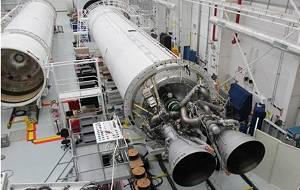
 Hot
Fire
Hot
Fire Inaugural Antares Reaches Orbit
Inaugural Antares Reaches Orbit A-ONE Antares Stands
on Wallops Island Pad 0A a Few Days Before Launch
A-ONE Antares Stands
on Wallops Island Pad 0A a Few Days Before Launch Antares A-ONE Rises
from Pad 0A
Antares A-ONE Rises
from Pad 0A The Initial Climb
Out was Slow due to Antares 1.2 Thrust to Weight Ratio
The Initial Climb
Out was Slow due to Antares 1.2 Thrust to Weight Ratio Antares/Cygnus Mission ORB-D1
Antares/Cygnus Mission ORB-D1 Rollout for ORB-D1 Mission
Rollout for ORB-D1 Mission  ORB-D1
Launch
ORB-D1
Launch Antares Launches
Cygnus Cargo Mission
Antares Launches
Cygnus Cargo Mission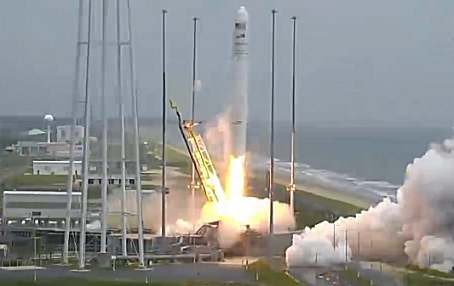 Antares
Launches Cygnus/Orb-2
Antares
Launches Cygnus/Orb-2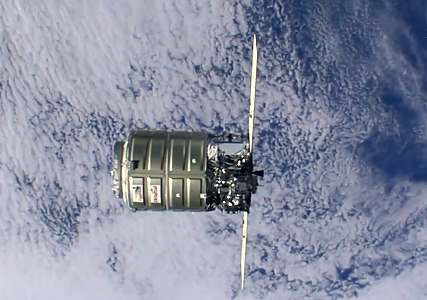 "Janice Voss" approaches ISS
"Janice Voss" approaches ISS 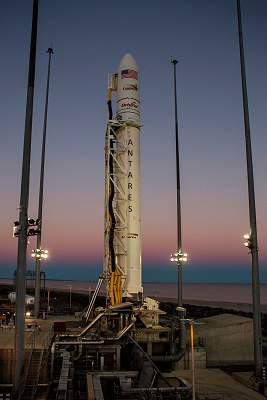 Antares/Cygnus Launch Fails
Antares/Cygnus Launch Fails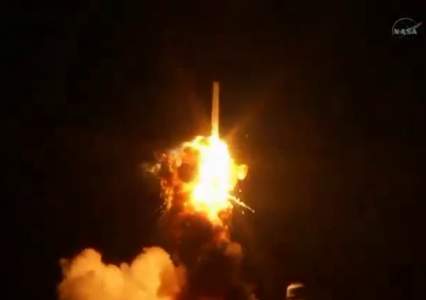 The Initial Fireball
The Initial Fireball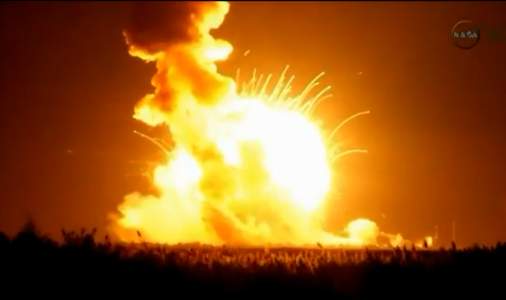 Ground Impact
Ground Impact